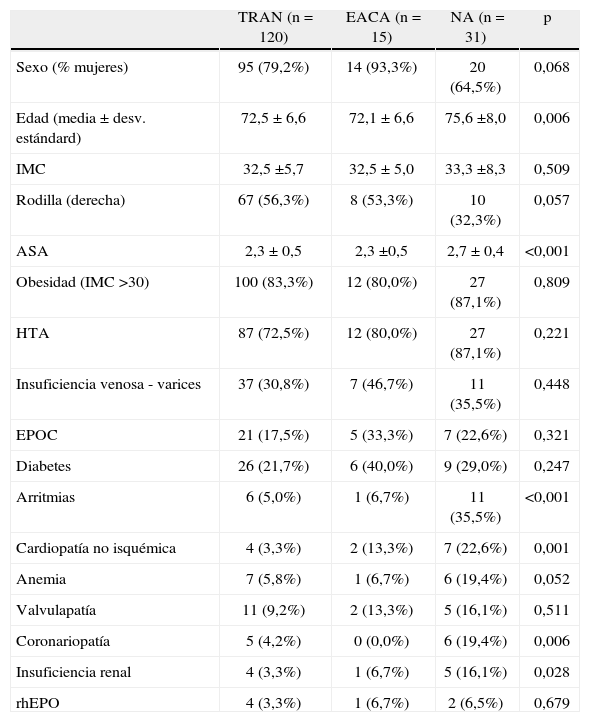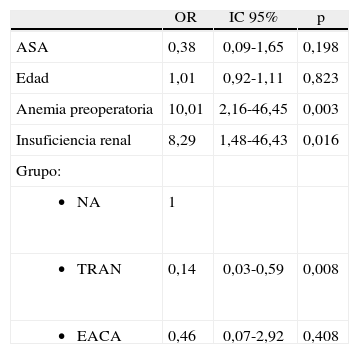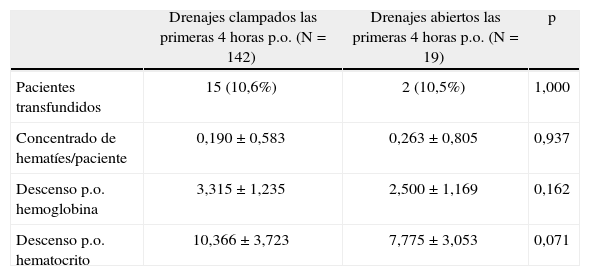Evaluar la efectividad en la práctica clínica habitual del tratamiento con ácido tranexámico (TRAN) versus no antifibrinolíticos (NA) en la disminución de la tasa de transfusiones y unidades de concentrados de hematíes (CH) requeridas en pacientes intervenidos de prótesis total de rodilla (PTR).
Material y métodoSe revisaron las historias clínicas de todos los pacientes intervenidos de PTR primaria en un hospital general durante el año 2006. Se registró: tratamiento con TRAN, utilización de otros antifibrinolíticos (AF), hemoglobina (Hb) y hematocrito (Hto) preoperatorios y al 3er día postoperatorio (p.o.), pacientes trasfundidos, unidades de CH administradas, y si se realizó o no el clampaje de los drenajes durante las primeras 4 horas del p.o. También se registraron las complicaciones relacionables con TRAN (tromboembólicas y/o sistémicas) y tratamiento preoperatorio con eritropoyetina (rhEPO).
ResultadosSe analizaron los datos de 166 pacientes. De éstos, 120 (72,3%) recibieron TRAN, 15 (9%) recibieron ácido épsilon-aminocaproico (EACA), y 31 (18,7%) no recibieron AF (NA). En total se transfundieron 17 (10,2%) pacientes, de los cuales 6 en TRAN (5,0%), 2 en EACA (13,3%), y 9 en NA (29,0%) (p<0,001). La media de CH transfundidas en cada grupo fue de 0,075 en TRAN, 0,200 en EACA, y 0,645 en NA (p<0,001). El descenso medio de la Hb al quinto día p.o. fue de 3,04 g/dl en TRAN, 3,55 en EACA, y 3,76 en NA (p=0,016).
ConclusionesEl TRAN es efectivo en la reducción del porcentaje de pacientes transfundidos y de CH administrados en PTR. No se encontró ninguna complicación relacionada con este tratamiento.
To evaluate the effectiveness of treatment with tranexamic acid, compared to absence of antifibrinolytic treatment, in reducing transfusion rates and the number of units of packed red blood cells required in patients undergoing total knee replacement surgery.
Material and methodsWe reviewed the medical records of all patients who underwent total knee replacement surgery in a general hospital in 2006. Information was recorded on treatment with tranexamic acid, use of other antifibrinolytic drugs, hemoglobin and hematocrit levels before surgery and 3 days after surgery, patients requiring transfusions, units of packed red blood cells administered, and whether or not drains were clamped within 4 hours. Complications attributable to tranexamic acid (thromboembolic or systemic complications) and preoperative treatment with erythropoietin were also recorded.
ResultsData for 166 patients were analyzed. Of these, 120 (72.3%) received tranexamic acid, 15 (9%) received ε-aminocaproic acid, and 31 (18.7%) received no antifibrinolytic treatment. Transfusions were given to 17 patients, of whom 6 (5.0%) had received tranexamic acid, 2 (13.3%) had received e-aminocaproic acid, and 9 (29.0%) had received no antifibrinolytic treatment. The mean numbers of packed red blood cell units transfused in each group were as follows: 0.075 in the tranexamic acid group, 0.200 in the ε-aminocaproic acid group, and 0.645 in the group with no antifibrinolytic treatment (P<.001). The mean decrease in hemoglobin levels 5 days after surgery was 3.04 g/dL in the tranexamic acid group, 3.55 g/dL in the ε-aminocaproic acid group and 3.76 g/dL in the group with no antifibrinolytic treatment (P<.001).
ConclusionsTranexamic acid is effective in reducing the percentage of patients requiring transfusions and in the number of units of packed red blood cells required in total knee replacement surgery. No complications attributable to this treatment were found.
Artículo
Comprando el artículo el PDF del mismo podrá ser descargado
Precio 19,34 €
Comprar ahora











